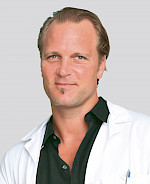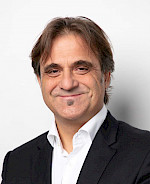
Shoulder dislocation
A shoulder dislocation occurs when the head of the humerus pops out of the socket of the shoulder joint.
This can happen if the capsules and ligaments between the head of the humerus and the socket of the shoulder joint are very loose. This is referred to as shoulder instability.
Symptoms
A dislocated shoulder can usually be identified externally due to the misalignment of the head of the humerus. Acute pain occurs and the movement of the shoulder is restricted.
Where numbness and tingling occurs in the arms, this can be a sign of nerve damage.
Causes
The main causes of a dislocated shoulder are either the individual falling directly onto the arm, or attempting to break their fall by using their arms. Due to the extreme force acting on the shoulder joint, overexertion occurs and the head of the humerus can pop out of the shoulder socket.
Shoulder dislocation is a very common shoulder injury that occurs in young and very athletic people.
There is a high risk of injury from sports that involve frequent falls, such as skiing, mountain biking or sports with opponent contact such as handball, basketball or American football.
Diagnosis
A shoulder dislocation can be diagnosed by palpating and examining the shoulder joint. X-rays are also used to help, and the X-ray image is also used to rule out further injuries that may have occurred as a result of the fall.
Since the dislocated shoulder may have damaged other areas, such as the joint capsule, tendons or the rim of the joint, an MRI is usually carried out, too.
Treatments
Conservative therapies
In certain cases, the shoulder can be relocated manually and surgery is not required. The repositioning must be carried out quickly in the hospital. However, after a shoulder dislocation, especially in young people, the individual can go on to experience frequent, recurring shoulder dislocations when there is little force or when performing everyday movements. After the correction, the shoulder is immobilised with an orthosis. The posture is intended to protect the shoulder and reduce pain.
The shoulder can be repositioned in one of two ways:
The Arlt manoeuvre – the patient sits on a chair and lets the dislocated arm hang over a padded armrest. The doctor pulls on the arm with the elbow bent, and attempts to move the arm back into its original position.
The hippocratic manoeuvre – the patient lies on their back. The doctor presses his or her own heel into the patient’s armpit while moving the dislocated arm outwards.
Before the fixation, the patient is given a strong painkiller. Treatment under anaesthesia is also an option.
Surgical treatment
If the patient also has other injuries or constant shoulder instability, shoulder dislocation can be treated surgically. This is done in the form of an arthroscopy. During the procedure, the overstretched ligaments are tightened, which prevents the risk of recurrent dislocation.
Aftercare
Aftercare is an important part of therapy and shoulder stabilisation. Four weeks after the operation, the shoulder is stabilised in an arm sling. To prevent adhesions, rehabilitation measures begin immediately after the operation.
In the first six weeks after surgery, the arm should not be externally rotated beyond zero degrees. The patient then undergoes a course of muscular stabilisation.
FAQs
How long does it take for a dislocated shoulder to heal?
After surgery, it can take up to six months for the shoulder to heal.
When can I start exercising again after the operation?
Light exercise and gentle sports can be resumed after two to three months. Contact sports or those with a high risk of falling should only be resumed after six months.
What are the risks associated with a shoulder dislocation?
In 5 to 10% of cases, there is a likelihood of residual instability and recurrent shoulder dislocation.






